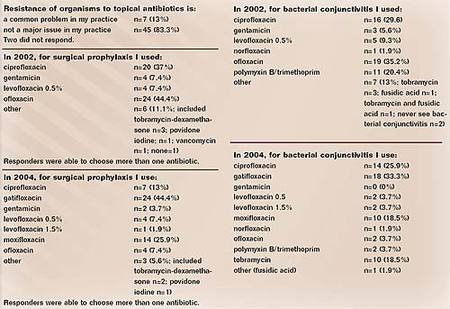OSN survey: Move seen to new generation of fluoroquinolones
In this exclusive independent survey, Ocular Surgery News investigated trends in the use of topical antibiotics.
As part of our Spotlight on Ocular Infection, Ocular Surgery News surveyed readers to try to identify trends in the use of topical antibiotics.
The survey responses, though small in number, demonstrate changing patterns in the use of topical antibiotics among respondents. Most of those who responded said they have moved to the newest generation of fluoroquinolones for both surgical prophylaxis and treatment of bacterial infections.
Two ophthalmic fluoroquinolones, gatifloxacin and moxifloxacin, received regulatory approval within weeks of each other in the spring of 2003. In March of this year, a stronger formulation of levofloxacin was approved.
As our survey was conducted in April, responses regarding this newest fluoroquinolone formulation are minimal. But the two drugs that have been on the market now for a full year seem to have made their way into many ophthalmologist’s practices.
In April, surveys were sent by e-mail to 524 randomly selected general ophthalmologists who subscribe to the OSN SuperSite NewsWire. After a 10-day period, 54 surveys were returned, a 10% response rate.
Participants were asked to identify the anti-infective medications they used in 2002, before the approval of the newest generation of fluoroquinolones, and in 2004. They were also asked to describe the reason for any change in preference that occurred during the past 2 years.
Surgical prophylaxis
Those who were polled were asked about the problem of resistance to topical antibiotics in their practices. Of those surveyed, 45 (83.3%) said resistance was not a major problem in their practices.
For surgical prophylaxis, 44.4% of respondents said that in 2002 they used ofloxacin, 37% said ciprofloxacin and 7.4% said levofloxacin 0.5%.
For surgical prophylaxis in 2004, 44.4% of respondents said they now use gatifloxacin, 25.9% said moxifloxacin and 7.4% said levofloxacin 0.5%. The newer levofloxacin 1.5% was named by one respondent (1.9%).
Use of the older fluoroquinolones for surgical prophylaxis dropped to 13% for ciprofloxacin and 7.4% for ofloxacin in 2004.
|
|
The survey included a question asking why respondents’ prescribing habits for surgical prophylaxis had changed. One respondent reported that the surgeon “had one case of endophthalmitis, which made me feel I should switch.” Other responses representative of several we received said the surgeon felt the newer drugs offer “better ocular penetration and coverage” and “much less corneal toxicity.”
One respondent said, “We tend to prescribe the latest, just to be sure.” Another cited a “surgical kit offered by the company” as the reason for change, and yet another cited a change to a different hospital with a different formulary.
Bacterial conjunctivitis
Respondents were also asked what medications they used against bacterial conjunctivitis in 2002 and 2004.
For bacterial conjunctivitis, 35.2% of those surveyed said in 2002 they used ofloxacin, 39.6% said ciprofloxacin and 9.3% said levofloxacin 0.5%.
In 2004, for bacterial conjunctivitis, 33.3% said they now use gatifloxacin, 18.5% said moxifloxacin and 3.7% said levofloxacin 1.5%.
Notably, 25.9% said for bacterial conjunctivitis they still use ciprofloxacin, while 3.7% still use ofloxacin and another 3.7% still use levofloxacin 0.5%.
To the question of why respondents changed their prescribing practice, typical responses included “more potent and increased broad-spectrum activity” and “better gram-positive coverage”; “lower likelihood of resistance.” One respondent said, “I felt I should use better/stronger meds.”
Finally, when asked how they intend to use the new generation of fluoroquinolones, 44.4% of respondents said they are likely to use them prophylactically for intraocular surgery, and 27.8% said they plan to use them as first-line therapy for acute bacterial conjunctivitis when available. In addition, 22.2% of respondents said they plan to keep these antibiotics in reserve for resistant organisms.

